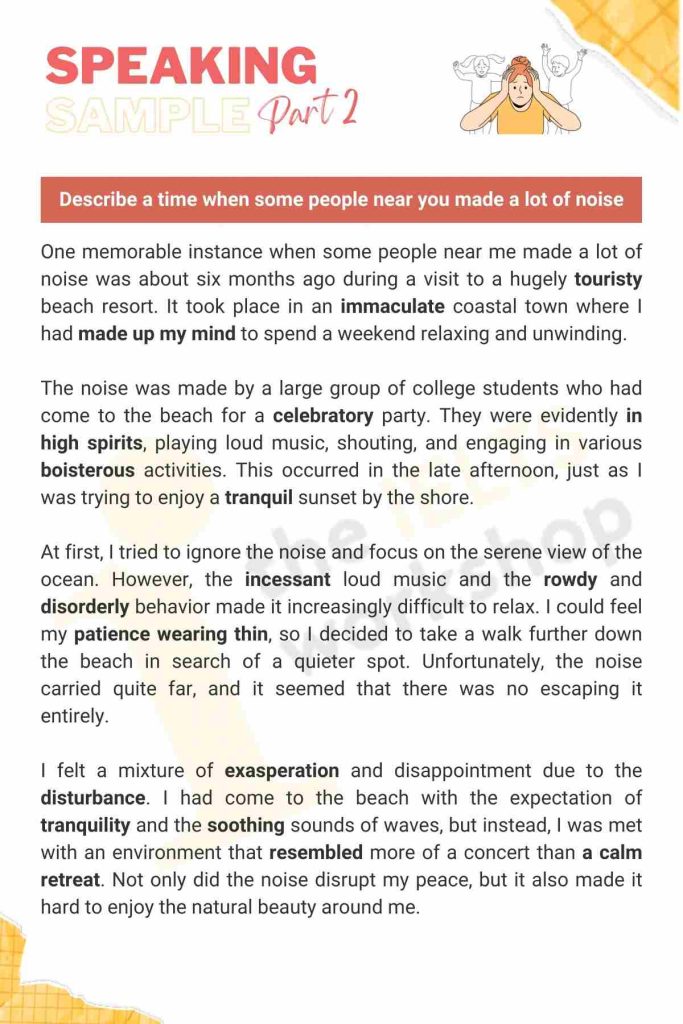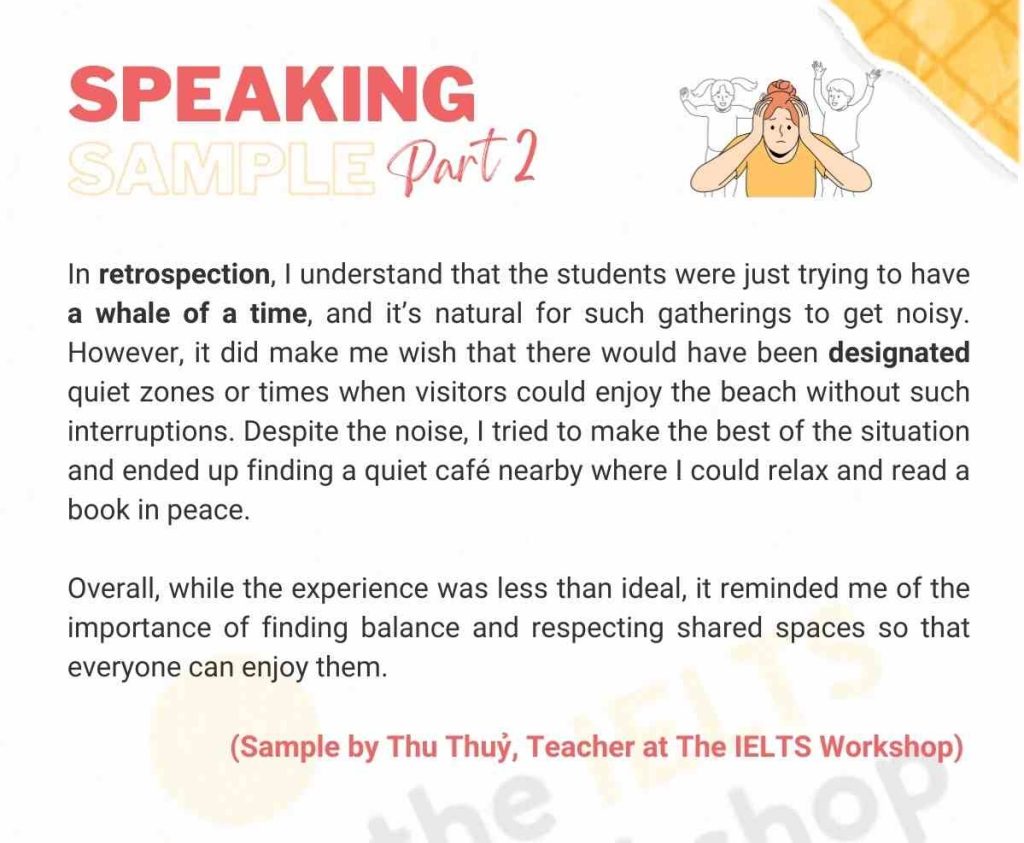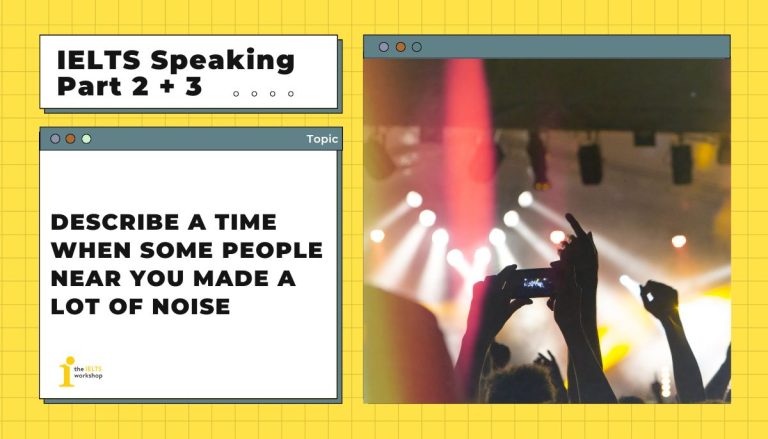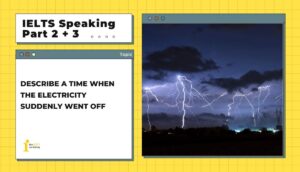Trong bài giải mẫu lần này, cô Thu Thuỷ của The IELTS Workshop sẽ hướng dẫn bạn trả lời topic “Describe a time when some people near you made a lot of noise“ trong IELTS Speaking Part 2. Cùng tham khảo sample, từ vựng và một vài cách diễn đạt ghi điểm trong phần thi IELTS Speaking nhé.
Part 2: Describe a time when some people near you made a lot of noise
Describe a time when some people near you made a lot of noise
You should say:
When and where it happened
Who made the noise
How you reacted to the noise
And explain how you felt about the noise
Dưới đây là bài mẫu cho topic “Describe a time when some people near you made a lot of noise“.
1. Bài mẫu (Sample)


2. Từ vựng (Vocabulary)
- interruptions = disturbances: sự quấy nhiễu
- touristy – nhiều khách du lịch
- immaculate – tinh khiết, không tì vết
- made up my mind – quyết định
- celebratory – mang tính chất ăn mừng
- in high spirits – rất vui vẻ, phấn khởi
- boisterous – náo nhiệt, ồn ào
- tranquil – yên bình
- incessant – không ngừng, liên tục
- rowdy – ầm ĩ, gây rối
- disorderly – lộn xộn, mất trật tự
- patience wearing thin – sự kiên nhẫn cạn dần
- exasperation – sự bực tức
- tranquility – sự yên tĩnh
- soothing – dịu dàng, dễ chịu
- resembled – giống như
- a calm retreat – một nơi yên bình để nghỉ ngơi
- retrospection – sự hồi tưởng lại
- whale of a time – một khoảng thời gian rất vui vẻ
- designated – chỉ định, dành riêng
Part 3:
Bên cạnh Part 2, bạn hãy tham khảo thêm Part 3 cho chủ đề này nhé
What kinds of places should be noise-free?
On what occasions do people need to be quiet?
Can people bring children to these noise-free places?
Why can’t people make noise in places like libraries and museums?
What public morals should people follow in your country?
Do you think we should allow children to make noise in public places?
1. What kinds of places should be noise-free?
Answer: There are several places that should ideally be noise-free to maintain an environment conducive to concentration, relaxation, or respect. Libraries are prime examples where silence is necessary to allow individuals to read, study, and think without disturbances. Also, hospitals and clinics should also be quiet to ensure that patients can rest and recover peacefully. What’s more, places of worship require silence to enable reflection, meditation, and prayer. And I do believe that museums and art galleries also benefit from a quieter atmosphere to allow visitors to fully appreciate the exhibits.
- Conducive to: Có lợi, thuận lợi
- Prime: Quan trọng nhất, hàng đầu
- Worship: Sự thờ phượng, sự tôn thờ
- Reflection: Sự suy ngẫm, sự phản chiếu
- Meditation: Sự thiền định, sự suy tư
2. On what occasions do people need to be quiet?
Answer: People need to be quiet during numerous occasions to show respect and consideration for others. For instance, during lectures, meetings, or any form of formal presentation, silence is required to allow the speaker to be heard clearly. In social contexts, such as during a funeral or memorial service, silence is a sign of respect for those grieving. By the same token, during a performance at a theater or concert hall, audiences are expected to remain quiet to ensure everyone can enjoy the experience without interruptions.
- Numerous: Đông đảo, nhiều
- Memorial service: Lễ tưởng niệm
- Grieving: Đang đau buồn, đang tiếc thương
3. Can people bring children to these noise-free places?
Answer: While it is possible to bring children to noise-free places, it requires careful consideration and preparation. Children need to be briefed on the importance of maintaining silence in such environments. For instance, in libraries or museums, parents or guardians should supervise children closely to ensure they understand and follow the rules. However, in places like hospitals, it might be more practical to limit visits by very young children who may not be able to stay quiet for extended periods.
- Briefed on: Được chỉ dẫn, được hướng dẫn
- Supervise: Giám sát, trông coi
- Extended periods: Khoảng thời gian dài
4. Why can’t people make noise in places like libraries and museums?
Answer: Noise is generally frowned upon in places like libraries and museums because it can disrupt the primary purpose of these environments. In libraries, noise interferes with people’s ability to concentrate on reading or studying. Similarly, museums are designed to offer a reflective and immersive experience, allowing visitors to appreciate and contemplate the exhibits. Excessive noise would detract from this experience, reducing the enjoyment and educational value for everyone present.
- Frowned upon: Bị phản đối, không được tán thành
- Interferes with: Cản trở, gây trở ngại
- Reflective: Suy tư, suy ngẫm
- Immersive: Đắm chìm, nhập vai
- Contemplate: Suy ngẫm, thưởng thức
- Detract from: Làm giảm giá trị, làm giảm đi
5. What public morals should people follow in your country?
Answer: In my country, there are several public morals that people are encouraged to follow to ensure a harmonious society. Respecting others is paramount, which includes being considerate of personal space and noise levels. On top of that, honesty and integrity are highly valued, whether in personal relationships or professional settings. Helping others and showing compassion, especially to those in need, is also a significant aspect of our public morals. What’s more, following rules and laws, such as those related to traffic and public behavior, is essential for maintaining order and safety.
- Paramount: Tối quan trọng, hàng đầu
- Integrity: Sự chính trực, liêm chính
- Professional settings: Môi trường chuyên nghiệp
6. Do you think we should allow children to make noise in public places?
Answer: While children naturally tend to be more exuberant and noisy, it’s important to strike a balance. In places where silence is essential, such as libraries or hospitals, it is crucial to maintain quiet to respect the needs of others. However, in more relaxed public places like parks or playgrounds, children should certainly be allowed to express themselves freely and make noise. The key is to teach children about context-appropriate behavior so they can understand when it is acceptable to be noisy and when it is important to be quiet.
- Exuberant: Hồ hởi, tràn đầy năng lượng
- Context-appropriate behavior: Hành vi phù hợp với ngữ cảnh
Bài mẫu bởi cô Thu Thuỷ – Giáo viên The IELTS Workshop
Các bạn có thể tham khảo Bộ đề dự đoán IELTS Speaking của The IELTS Workshop để ôn tập những chủ đề mới cho kỳ thi IELTS sắp tới của mình nhé!
Nếu bạn muốn nhận Mentor 1-1 để hoàn thiện kĩ năng Speaking của mình trước khi bước vào kỳ thi, tham khảo ngay Khóa bổ trợ từng kỹ năng IELTS của The IELTS Workshop.









